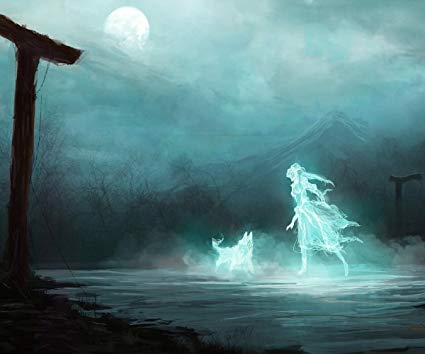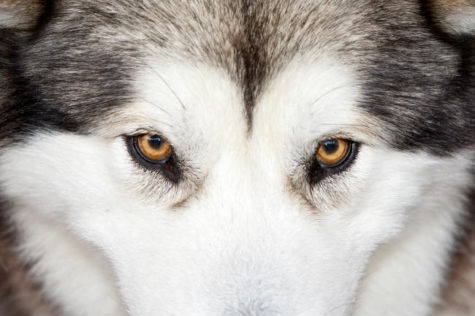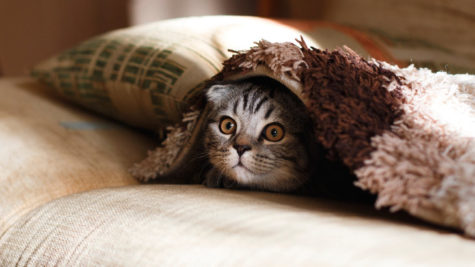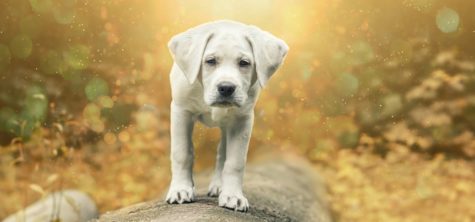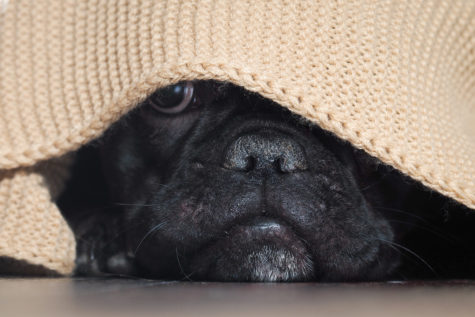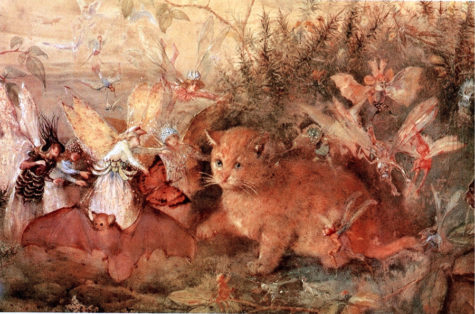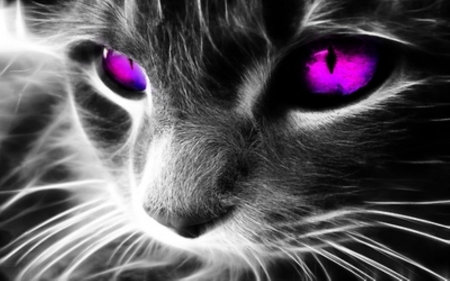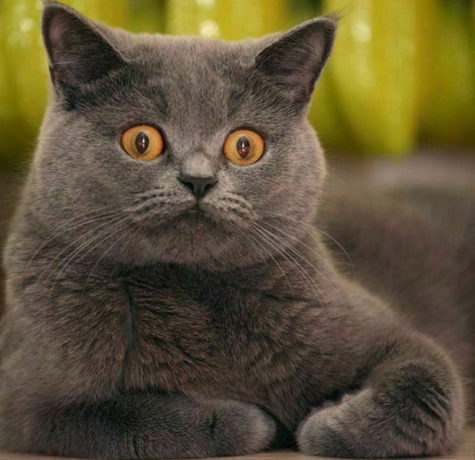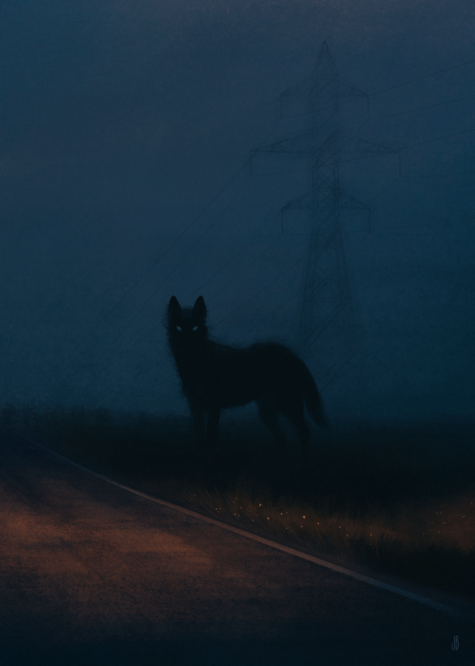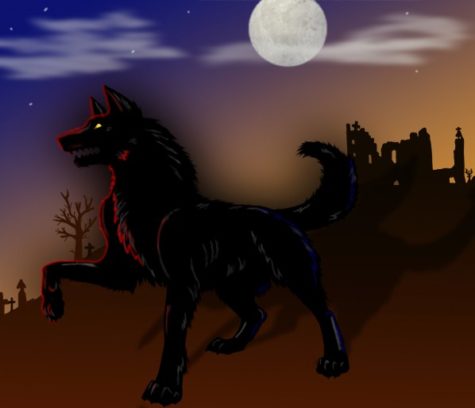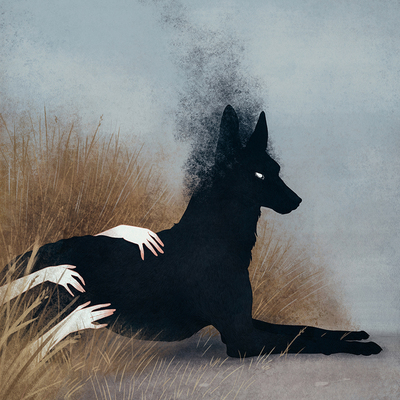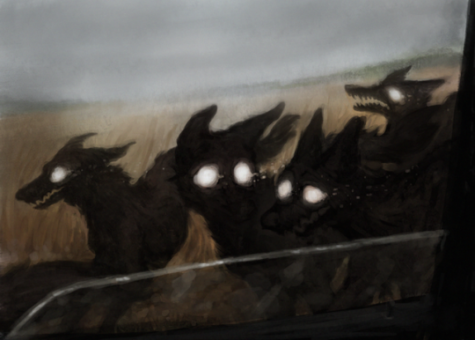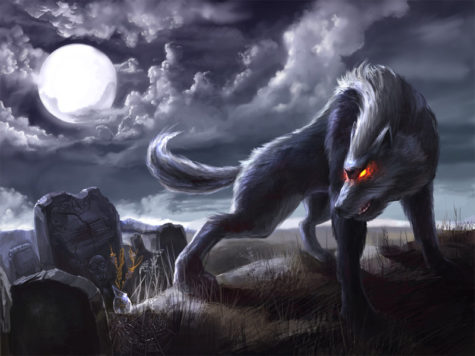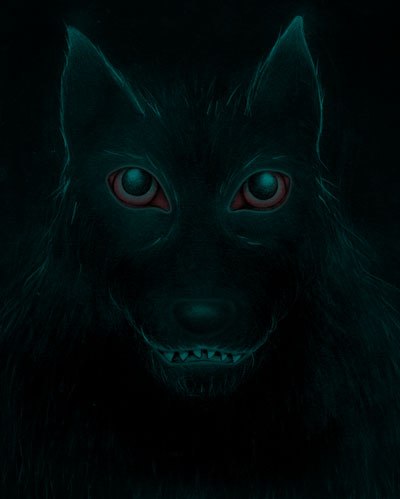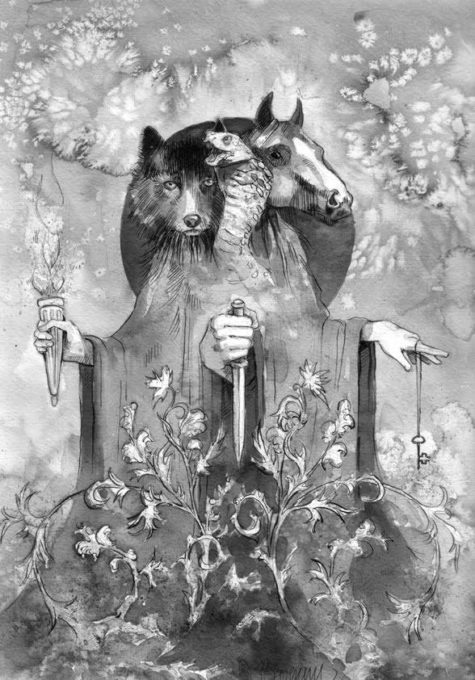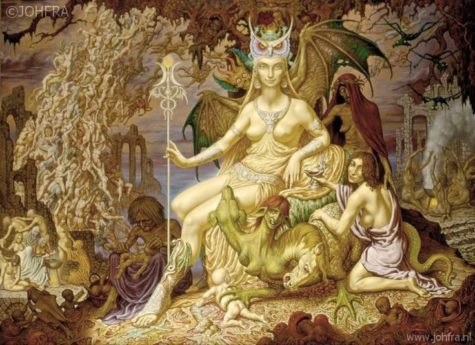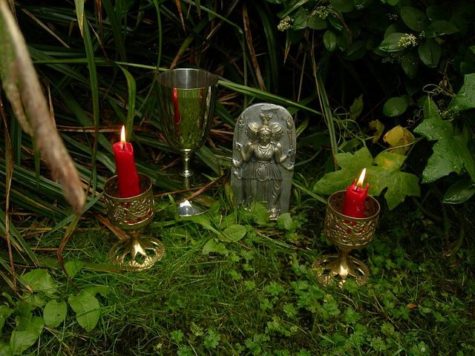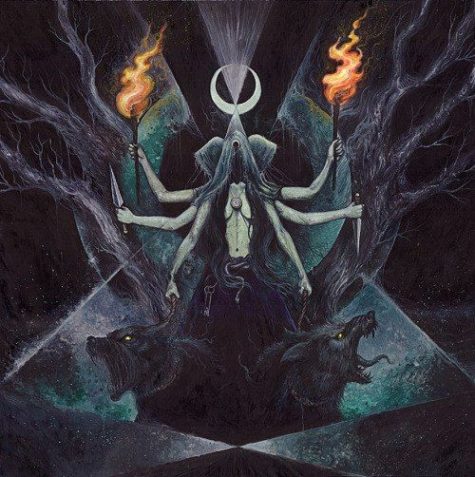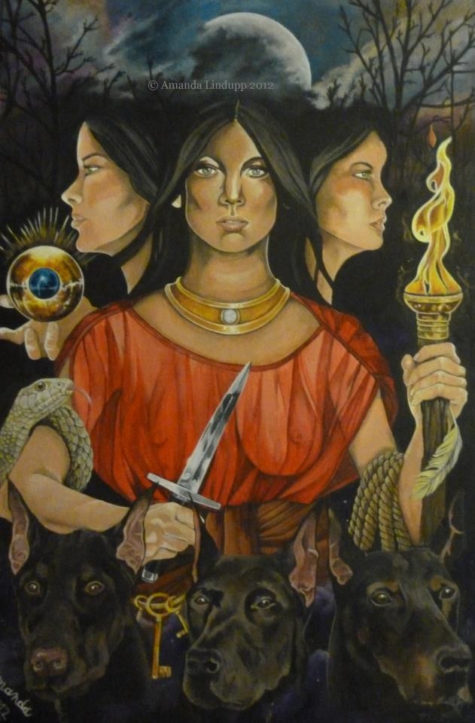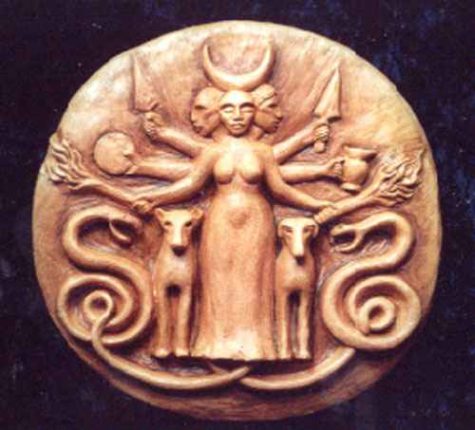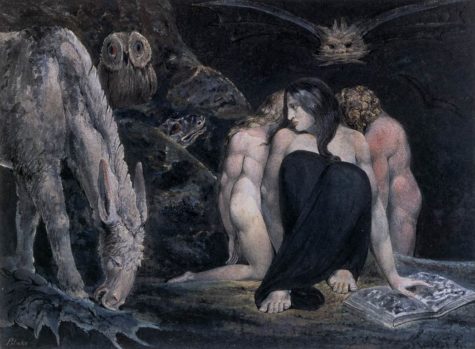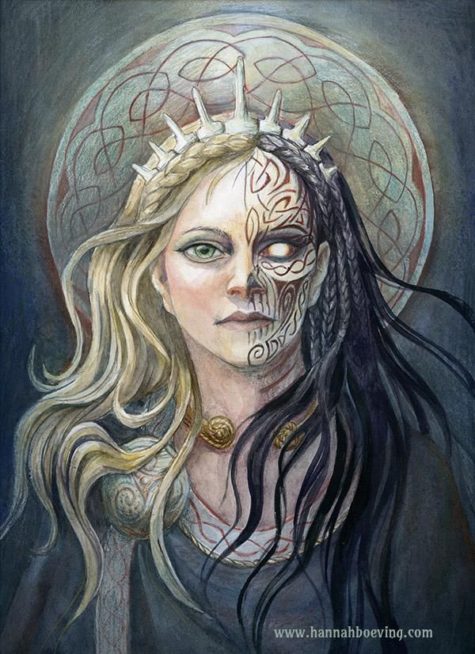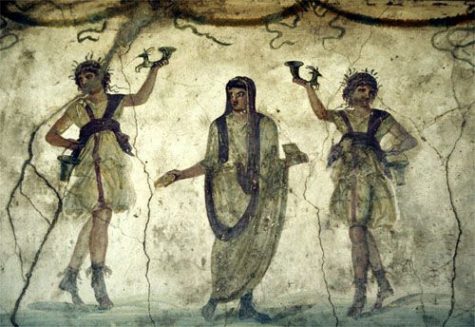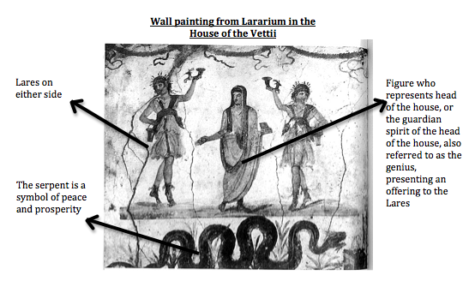Dogs
Do you feel like some other entities exist around us, just as ultraviolet rays exist around us that we can’t perceive, and only certain animals are, perhaps even only sometimes, aware of them? Even mainstream science recognizes cats, dogs, and other animals can see frequencies humans can’t. It’s well known that dogs and cats have much better senses than humans.
According to Animal Planet, a dog’s eyes “detect more delicate movements; his sense of smell is 1,000 to 10,000 times more sensitive than a human’s. He can hear much higher frequencies, and at four times the distance of a human with normal hearing.” This, some claim, could mean that dogs and other animals also sense the paranormal, and are often more accepting of it.
Their keen senses mean that animals may also have the ability to predict earthquakes, a belief that, as National Geographic reports, dates back centuries. In records from the year 373 BC, historians noted that many animals, “including rats, snakes and weasels” fled the Greek city of Helice prior to a devastating earthquake. This is a phenomenon that continues to be observed to this day, though it is still not fully understood.
Of course, there’s a big difference between earthquakes and spirits. However, this simply goes to underline the fact that animals, including dogs and cats, may sense many things that we are not able to.
It makes sense scientifically in a separate way from spiritually. It’s simple really: the scientific explanation is that cats and dogs can see UV light and a few other rays, which human retinas don’t have the ability to see.
According to Pet MD:
“Have you ever felt that your cat or dog can see something you don’t? Well, you may be right, according to a new study. Cats, dogs, and other mammals are thought to see in ultraviolet light, which opens up a whole different world than the one we see, the study explains.
UV light is the wave length beyond the visible light from red to violet that humans can see. Humans have a lens that blocks UV from reaching the retina. It was previously thought that most mammals have lenses similar to humans.
Scientists studied the lenses of dead mammals, including cats, dogs, monkeys, pandas, hedgehogs, and ferrets. By researching how much light passes through the lens to reach the retina, they concluded that some mammals previously thought not to be able to see UV actually can.”
Many studies that have been carried out on the senses of dogs offers quite a debate on the psychic abilities and sensory perceptions of them. There is, of course, no way to know what is really going on because we cannot communicate on the level we would need to for confirmation.
A Personal Experience
I believe there is something more to this phenomena that delves into the metaphysical realm.
My little sister and I have had experiences where our cats see things that aren’t there. They bat at the air with their paws, meow, hiss, and make strange noises at things that we can’t see.
The most profound time it occurred was right after my grandfather passed. Our cat named Double Stuff was batting at the air, meowing very strangely, and chasing something around the room, trying to jump at it in the air, looking at this thing on the ceiling.
It was almost as if some spirit or entity was floating around on the ceiling and only the cat could see it.
There was no different UV light in my room when the cat did this: so why would the cat only at that time try to chase some invisible things?
Then a few weeks ago, my sister experienced seeing “shadow people,” a phenomena commonly reported by people who suffer from sleep paralysis.
As she saw these shadow entities around the house at night (given that it wasn’t an illusion), the cat started acting strange and scared. It meowed, hissed, did the same things it did before but in a scared way, not bewildered and interested.
Signs Your Dog Is Seeing Spirits
So, what will your dog do if they see a spirit? We’re not exactly sure! We do know there are a few things your dog might do if they see something you don’t, though. You might notice your dog’s body stiffen and they might start growling or barking. They might also put their ears up and sniff to get more information about what they are seeing. Dogs use their senses of hearing and smell much like humans use their sense of sight. So, you might see your dog doing more with their nose or ears than their eyes or paws.
Here are some signs you might notice if your dog sees or smells something you don’t:
- Growling
- Barking
- Sniffing
- Ears
- Staring
- Running around
- Odd behavior
Since we don’t have much information about dog-spirit sightings, we are left to speculate what your pup might do. They might think the spirit is an intruder and chase them around. Some spirits have been known to be good with animals, though. So, your pooch might like the spirit. It all depends on the situation.
If your dog is staring into the air at nothing or chasing something you can’t see, could it be something supernatural? Maybe!
Another Personal Experience:
Reddit user Lillibeth shared the following story two years ago. She had recently moved into an old house with her grandparents. The place was about 100 years old and, in her words, “creepy.”
One night, she and her dog, Lola, were about to go to bed. But Lola began to act strangely. She jumped up and went to the bed’s edge, as if to look over. Her eyes then began to follow something in the air, something invisible.
“I would call her name and she wouldn’t move,” Lillibeth wrote. She turned on the light to see if perhaps Lola was being pestered by a fly or a mouse, but she saw nothing. Then, as if in fear, Lola curled up against Lillibeth, occasionally glancing over the edge of the bed throughout the night.
Was Lola afraid of something her owner could not see?
These are questions I suppose we can’t answer. We can’t speak to our pets and know what they’re thinking. What are their eyes following when we see nothing there? Why are they barking or growling, why are they afraid?
Has your pet ever acted strangely? Do you believe it was a ghost?
And What About Cats?
Can cats see ghosts? How about angels? Fairies? Or even demons?
Well, animals may not use a language to communicate like humans but a true animal observer will realize that animals do communicate very well with their sounds and body language.
The cat is one such species and apart from communicating with their owners, they have a connection with each other as well.
It might seem a bit unusual for humans who consider this preposterous but if you observe cats keenly, they are not as unintelligent as many of us might consider them to be.
Some of the Feline observers have found their cats staring continuously at a particular spot from later they found unusual sounds coming from the same spot.
Other instances include cats sense ghosts and staring at the stairway like someone is walking up and down and later it looks like they are trying to fight something off their face.
Some of us might consider it as playing or other might just think this is the way cats behave. But is that really true?
There was another cat who lived with his pet owner and kept staring at a room, later the owner said that she could hear some unusual sounds coming from the room.
Did the cat see anything that was not visible to the naked eye? It has been predicted that cats can see things from the spiritual world which normal people usually cannot.
After a few studies it has been found that cats genuinely know more than humans, they feel the vibrations and that is the reason they despise people who are not fond of cats.
It is quite shocking but they can sense the negativity coming from them and they too tend to stay away from such people or you might find them hissing while such people are around.
They even know when their owners are going to arrive and who loves them the most. They are even capable of realizing any danger that is near them or near their pet parents.
They even understand when their caretaker is sad or hurt and such telepathic traits make it more suspicious that they are completely capable of sensing people who have left their bodies (souls).
Do Cats Protect Us From Spirits?
It has been observed that cats behave weird when they sense an unusual presence around them. It is even said that they do not like a place if they sense any psychic presence there. It has been said in the Ancient Egyptian mythology that cats are blessed with the power to ward away evil spirits, but is that true?
There have been sayings that dogs bark in the night in order to ward away any evil spirits. The same has been the case with the feline creatures as well.
Buddhists believe that cats are the souls of the dead who live in the bodies of cats before they get another new life. Cats are also believed to see any aura or evil presence around human beings.
Many believe that cats can easily predict future as they get to ‘know’ or can easily sense feelings.
They certainly may not be able to completely protect you from evil spirits but can certainly warn you if anything bad is to happen.
Signs Your Cats Are Seeing Spirits
The ancient Egyptians worshiped them as gods, and believed that cats took on a spiritual importance and were considered to be a sacred animal with magical powers. In some myths, cats are able to walk in and out of the spirit world as they please.
Is it true? Can cats see ghosts? Here are some signs to look out for.
- The out of nowhere poofy tail and flat ears.
You’re just sitting there, watching netflix… and you get a sudden chill down your spine. You look over and see your cat all puffed up and looking scary. Yep… Your cat is looking at a ghost.
- They stare at seemingly nothing, like the corner of the wall or ceiling.
Ever been lying in bed and your cat suddenly perks up and is staring at the ceiling above your head? It could be a spirit, a ghost, or even fairies or an angel.
- The loud bump in the night but your cat is sitting next to you.
We hear bumps in the night and us cat owners know that it must be Fluffy running around doing cat stuff. Then you remember that Fluffy is curled up next to you and you see him staring out towards the dark hallway… Possible explanation? A ghost is messing with your stuff and your cat is watching it happen.
- Your cat’s sudden disappearance and sudden reappearance.
One second you see your cat walk into the room, the next second, he’s gone. You call and look everywhere… but no signs. You check their usual spots, above the kitchen counters, under the bed, in the cat tree, the litter box… nothing….
This is simple. Your cat has found the portal into the ghost dimension and curiosity got the best of him. Don’t worry – he’ll return. Cats can come and go as they please. Shake some treats and your cat will suddenly appear in front of you again.
- Growling or hissing at something invisible.
You’re just minding your own business, sipping a glass of wine and watching The Walking Dead when your cat stares behind you and begins to hiss… even worse… growl. Of course you’re home alone… but you feel the hairs on your neck rise. Your cat sees something… a ghost? Or something else?
- Playing with an invisible friend.
There are times when you might have seen a cat behave weirdly as if something exists around or as if it is playing with something. This might be seen as a playful nature but not all the times can you tell that.
- Looking at someone who isn’t there.
There are a few owners who have said that they have seen their cats eyeballs move as if it was looking at someone walking by or running up and down the stairs.
Sources:
The Black Dog is among Britain’s most famous spectral hounds. It may be dangerous and malevolent or helpful and benevolent. It usually serves as a guardian of treasure or a sacred place. If left alone, it usually leaves you alone, too, but if aggression is shown toward it, the Black Dog isn’t afraid to demonstrate supernatural powers, potentially causing terrible wounds, paralysis, or death before vanishing into thin air.
- Manifestation: A shaggy black dog the size of a calf with glowing, red eyes.
- Other names: Moddey Dhoo, Mauthe Doog, Black Shuck, Old Shuck, Old Shock
This ghostly canine is also known as Mauthe Doog, a calf sized black dog who haunts Peel Castle on the Isle of Man. Guards saw the specter so often, they eventually grew less fearful. But, according to lore, one drunk soldier went down a passage in the castle to confront the ghost dog. He came back too terrified to speak and died three days later. The passage was sealed and never used again. Mauthe Doog sightings, however, continued.
Black Shuck
Black Shuck, Old Shuck, Old Shock or simply Shuck is the name given to a ghostly black dog which is said to roam the coastline and countryside of East Anglia, one of many ghostly black dogs recorded in folklore across the British Isles. Accounts of Black Shuck form part of the folklore of Norfolk, Suffolk, the Cambridgeshire fens and Essex, and descriptions of the creature’s appearance and nature vary considerably; it is sometimes recorded as an omen of death, but, in other instances, is described as companionable.
According to the Oxford English Dictionary, the name Shuck derives from the Old English word scucca – “devil, fiend”, from the root word skuh- to terrify. The first mention in print of “Black Shuck” is by Reverend E.S. Taylor in an 1850 edition of the journal Notes and Queries which describes “Shuck the Dog-fiend”;
“This phantom I have heard many persons in East Norfolk, and even Cambridgeshire, describe as having seen as a black shaggy dog, with fiery eyes and of immense size, and who visits churchyards at midnight.”
Images of black sinister dogs have become part of the iconography of the area and have appeared in popular culture. Writing in 1877, Walter Rye stated that Shuck was “the most curious of our local apparitions, as they are no doubt varieties of the same animal.”
Descriptions of Black Shuck vary in both shape and size, from that of a large dog to being the size of a calf or horse. W. A. Dutt, in his 1901 Highways & Byways in East Anglia describes the creature thus:
He takes the form of a huge black dog, and prowls along dark lanes and lonesome field footpaths, where, although his howling makes the hearer’s blood run cold, his footfalls make no sound. You may know him at once, should you see him, by his fiery eye; he has but one, and that, like the Cyclops’, is in the middle of his head. But such an encounter might bring you the worst of luck: it is even said that to meet him is to be warned that your death will occur before the end of the year.
So you will do well to shut your eyes if you hear him howling; shut them even if you are uncertain whether it is the dog fiend or the voice of the wind you hear. Should you never set eyes on our Norfolk Snarleyow you may perhaps doubt his existence, and, like other learned folks, tell us that his story is nothing but the old Scandinavian myth of the black hound of Odin, brought to us by the Vikings who long ago settled down on the Norfolk coast.
Dr Simon Sherwood suggests that the earliest surviving description of devilish black hounds is an account of an incident in the Peterborough Abbey recorded in the Peterborough Chronicle (one version of the Anglo-Saxon Chronicle) around 1127.
This account also appears to describe the Europe-wide phenomenon of a Wild Hunt.:
Let no-one be surprised at the truth of what we are about to relate, for it was common knowledge throughout the whole country that immediately after [Abbot Henry of Poitou’s arrival at Peterborough Abbey] – it was the Sunday when they sing Exurge Quare – many men both saw and heard a great number of huntsmen hunting.
The huntsmen were black, huge and hideous, and rode on black horses and on black he-goats and the hounds were jet black with eyes like saucers and horrible. This was seen in the very deer park of the town of Peterborough and in all the woods that stretch from that same town to Stamford, and in the night the monks heard them sounding and winding their horns.
Reliable witnesses who kept watch in the night declared that there might well have been as many as twenty or thirty of them winding their horns as near they could tell. This was seen and heard from the time of his arrival all through Lent and right up to Easter.”
Abraham Fleming’s account of the appearance of “A strange, and terrible wunder” in 1577 at Bungay, Suffolk is a famous account of the beast.
“A straunge, and terrible Wunder wrought very late in the parish church of Bongay: a town of no great distance from the citie of Norwich, namely the fourth of this August, in the yeere of our Lord 1577. in a great tempest of violent raine, lightning, and thunder, the like wherof hath been seldome seene. With the appeerance of an horrible shaped thing, sensibly perceiued of the people then and there assembled. Drawen into a plain method according to the written copye. by Abraham Fleming.”
One of the most notable reports of Black Shuck is of his appearance at the churches of Bungay and Blythburgh in Suffolk. On 4 August 1577, at Blythburgh, Black Shuck is said to have burst in through the doors of Holy Trinity Church to a clap of thunder. He ran up the nave, past a large congregation, killing a man and boy and causing the church steeple to collapse through the roof. As the dog left, he left scorch marks on the north door which can be seen at the church to this day.
The encounter on the same day at St Mary’s Church, Bungay was described in A Straunge and Terrible Wunder by Abraham Fleming in 1577:
This black dog, or the divel in such a linenesse (God hee knoweth al who worketh all,) running all along down the body of the church with great swiftnesse, and incredible haste, among the people, in a visible fourm and shape, passed between two persons, as they were kneeling uppon their knees, and occupied in prayer as it seemed, wrung the necks of them bothe at one instant clene backward, in somuch that even at a mome[n]t where they kneeled, they stra[n]gely dyed.
Fleming was a translator and editor for several printing houses in London, and therefore probably only published his account based on exaggerated oral accounts. Other local accounts attribute the event to the Devil (Fleming calls the animal “the Divel in such a likeness”). The scorch marks on the door are referred to by the locals as “the devil’s fingerprints”, and the event is remembered in this verse:
All down the church in midst of fire, the hellish monster flew, and, passing onward to the quire, he many people slew.
Dr David Waldron and Christopher Reeve suggest that a fierce electrical storm recorded by contemporary accounts on that date, coupled with the trauma of the ongoing Reformation, may have led to the accounts entering folklore.
Littleport, Cambridgeshire is home to two different legends of spectral black dogs, which have been linked to the Black Shuck folklore, but differ in significant aspects: local folklorist W.H. Barrett relates the story of a huge black dog haunting the area after being killed rescuing a local girl from a lustful friar in pre-reformation times, while fellow folklorist Enid Porter relates stories of a black dog haunting the A10 road after its owner drowned in the nearby River Great Ouse in the 1800s.
Sources:
Hekate is an exceptionally powerful spirit. She holds dominion over life, death, regeneration, and magic. She rules wisdom, choices, expiation, victory, vengeance, and travel. Hekate guards the frontier between life and death. She is an intermediary between the spirit world and that of humans. She is the witness to all crimes, especially those against women and children.
Hekate (Hecate) is Queen of the Night, the Spirit World, and Witchcraft. Her epithets include:
- She Who Works Her Will
- The Most Lovely One
- Influence From Afar
- Three Headed Hound of the Moon
- The One Before The Gate
- Light Bringer
Although today most associated with Greek mythology, her name, meaning “influence from afar,” acknowledges her foreign origins.
Generally believed to have first emerged in what is now Turkey, she was not an obscure goddess. Hekate was at one time chief deity of Caria, now western Turkey, and was eventually widely worshiped throughout Europe, Western Asia, and Egypt. Records of formal worship date from eighth century BC to the fourth century AD, although as magic fell from grace she became an increasingly disreputable spirit. All Hekate’s myths clearly identify her as a witch and matron of magical arts.
Hekate is renowned for her expertise with plants and her knowledge of their magickal and healing powers. A famed magickal garden was attached to her temple in Colchis on the Black Sea, now in modern Georgia. Some scholars suggest that an ancient Greek women’s guild, under the divine matronage of Hekate, once had responsibility for gathering and storing visionary, hallucinatory and poisonous plants. The same work in Greek indicates “pharmacist,” “poisoner,” and “witch.”
Petitioning Hekate
Hekate is a goddess of life, death, regeneration and magick. She rules wisdom, choices, expiation, victory, vengeance, and travel. She is witness to every crime.
- She is invoked for justice, especially for sexual crimes against women and girls.
- Hekate is invoked when justice is not forthcoming from other channels.
- Hekate has the power to grant or deny any mortal’s wish.
- She may be invoked for protection for dogs and from dogs.
- Hekate is petitioned for fertility, especially for female children.
- She brings victory in battle.
- Hekate may be invoked for healing, especially if medical solutions have failed.
- She may be petitioned for swift, painless death.
- Hekate can banish ghosts – or produce a ghost infestation.
Hekate typically responds to petitions via visions and dreams. If lost at a crossroads, literal or metaphoric, invoke her name and then pay attention to signs from her. She can be a shadowy, oblique goddess: her response may be subtle. Look for her animals: snakes, dragons, cats, and especially dogs.
- Favored people
Midwives, witches, healers, herbalists, dog lovers and rescuers. She is the matron of women in general and protects those who ride horses.
A Living Altar
Hecate is most famous today as a Dark Moon Spirit and Queen of Witches. Those are but two aspects of this multifaceted deity. Hecate was once the chief deity of the Carian nation, now in Western Turkey. She is matron of the city of Istanbul. She has dominion over life and death and makes the journey in between, indicating her power as a healing deity. Hecate is matron of midwives and herbalists.
Her priestesses (the most famous was Medea) were trained herbalists. Those in need of healing or solace journeyed to the gardens attached to Hecate’s shrine in Colchis on the Black Sea, home of the Golden Fleece pilfered by the Argonauts.
Hecate’s assistance may also be accessed by building a living altar in her honor. Plant a garden outdoors or create a living altar inside with potted plants. Add some or all of the following:
- Dog roses,
- Garlic,
- Lavender,
- Mandrake,
- Queen of the Night,
- Roses,
- Thorn apple,
- Tuberoses.
Hecate’s trees include:
- Black poplar
- Date palm
- Pomegranate
- Willow
- Yew
Place votive images of Hecate, together with her favorite creatures – dogs, dragons, and snakes – in the garden. To petition Hecate directly or to receive spontaneous magical inspiration regarding your healing needs, sit in or beside your living altar in the dark.
To Summon Hekate
Hecate, Queen of Witches, maintains office hours only at night: formal petitions and invitations must be offered after dark. A particularly ancient spirit, the only source of illumination she favors is fire.
Summon Hecate at night by a three-way crossroads. Ideally, light your way with a mullein torch. Offer her garlic, lavender, and honey. If you have a dog, bring it with you. Keep an eye on the dog; it’s likely to perceive Hecate before you do.
Why would you wish to contact Hecate?
Because she can teach you to do anything with magic. Because she can grant you enhanced psychic powers, fertility, romance, protection, freedom from illness, and magical restitution for any crime committed against you.
Hekate has been with us for at least three thousand years.
She was a liminal goddess who was present at all the boundaries and transitional moments in life. She was also an ‘evil-averting’ protector and guide. Her triple form emphasized her power over the three realms, these being the heavens, sea, and earth. Her primal nature was seen in the many animal heads she was depicted with, each emphasising different qualities of her manifold character.
Some of her well known titles include:
- Chthonia – earthy one
- Dadouchos – torch bearer
- Enodia – of the ways
- Kleidouchos – key bearer
- Kourotrophos – child’s nurse
- Phosphorus – light bearer
- Propolos – companion
- Propylaia – before the gate
- Soteira – savior
- Triformis – three bodied
- Trioditis – of the three ways
To enhance your ability to summon Hecate, try this:
Dry dandelion roots, then slice and pierce them to create beads, forming a ritual necklace to wear when calling Hecate. Call – or think – Hecate’s name as you pierce, string, and knot each bead. For best results, string the necklace at night by firelight.
Another way to enhance your relationship with the Queen of the Night is to practice the Silence of the Night Meditation. It’s a very simple yet profoundly powerful meditation, especially when practiced for an extended period of time.
Manifestations
Hekate has been known to assume the shape of a black cat, a bear, a pig or a hen but most typically manifests as a mature woman or black dog. She has a particularly strong bond with dogs. Even when manifesting in human form, Hekate is usually accompanied by hounds. Somehow there will be a canine reference. When manifesting as a woman alone, Hekate often circles in the manner of a dog.
Artistic renderings of Hekate usually attempt to capture her spiritual essence. She may be depicted with three bodies, each facing a different direction. One hand holds the knife that is the midwife’s tool, another holds a torch to illuminate the darkness, the last bears a serpent representing medical and magical wisdom. Sometimes Hekate is depicted with a woman’s body but three animal heads – those of a dog, a horse, and a lion.
Hekate, Queen Witch, is a shape-shifter supreme. While her usual manifestations are as a black dog or mature woman, she may manifest as a haggard, decrepit crone or a sexy, elegant, seductive woman. She even has an occasional mermaid manifestation. She may wear snakes in her hair. Every now and then, she appears as a black cat, snake, or dragon.
Sacred to Hekate
Hekate’s sacred time is black night. All her festivities and ceremonies are held after dark, the only acceptable illumination is candles or torches. She only accepts offerings and petitions at night. Hekate is identified with the Dark Moon, the time of her optimum power.
The last day of each month is dedicated to Hekate. She also shared a festival with Diana on August 13th in Italy. Modern Wiccans, for whom Hekate is an important deity, celebrate November 16th as Hecate Night of the Crossroads.
- Animals: Black ewe lambs, Boar, Bull, Cats, Cock, Cow, Dogs, Dragons, Fish, Goats, Horses, Lions, Mice, Mullet (fish), Polecat, Rams, Serpents, Toads, Wolf
- Attributes: Key, Cauldron, Broom, Torch, Knife
- Bird: Stork
- Color: Black, also Red, White, Yellow
- Emblem: Star and crescent moon
- Food: Eggs, Honey, Amphiphon Cakes (a cheesecake with lighted candles stuck into it)
- Fruit: Pomegranate
- Minerals: Copper, Gold, Loadstone, Meteorite, Sapphire
- Mount: Dragons pull her chariot
- Number: Three
- Planets: Moon (especially the dark moon), and Sirius, the Dog Star
- Plants and herbs: Aconite, Anise, Belladonna, Garlic, Grain, Henna, Lavender, Mandrake, Onion, Poppy, Saffron,
- Symbols: Dagger, Keys, Horned Crescent, Pegasus, New Moon, Three-Way Crossroads, Trident, Twin Torches
- Trees: Apples, Black poplar, Date palm, Oak (leaves), Pomegranate, Willow, Yew
Her sacred place is the crossroads, specifically three-way crossroads. Among her name is Hecate Trivia. That doesn’t indicate that Hekate is trivial or that worshiping her was a trivial pursuit: Trivia literally means “three roads.” Hekate is Spirit of the Crossroads: her power emanates from their point of intersection. Hekate’s image was once placed in Greek towns wherever three roads met.
Hecate is the Goddess of the dark of the moon, the black nights when the moon is hidden. She was associated with deeds of darkness, the Goddess of the Crossways, which was held to be ghostly places of evil magic, an Awful Divinity,
“Hecate of hell
Mighty to shatter every stubborn thing.
Hark! Hark! Her hounds are baying through the town.
Where three roads meet, there she is standing.”
Rituals
Hekate’s ancient devotees held dinners in her honor, known as Hekate Suppers. Foods associated with her were prepared. The entree was usually fish, especially red mullet. Devotees feasted and celebrated. Offerings and leftovers were placed outside the door or at a crossroads for Hekate and her hounds.
- The last day of each lunar month is dedicated to Hekate.
- Friday the 13th – particularly if it falls in the month of August.
- November 16th is Hekate Night
- August 13th, in Italy, a festival is shared between Diana and Hekate
Even way back when, cynics scoffed that food placed outside was actually consumed by feral dogs and homeless people without realizing that this is Hekate’s intent: this is one way she accepts offerings. (The Church was still trying to eradicate this ritual as late as the eleventh century.)
Smaller, private offerings may be left at a crossroads, too:
- Place offerings on a plate or flat stone and leave them at a crossroads after dark.
- Make your invocation and then walk away without looking back.
- Do not return for the plate, or any part of the offering, but consider it part of your gift.
Offerings can include the following:
- Eggs
- Garlic and honey (especially lavender honey)
- Croissants and crescent shaped breads and pastries
- Candles
- Incense
- Images of dogs, especially black dogs
- Actions on behalf of dogs
Encountering or hearing a dog is an indication that your petition has been heard.
The Mythology
According to myth, Hekate once served as an Angelos, a messenger for the other deities. She stole Hera’s beauty salve to give to her rival Europa. Hera enraged, pursued Hekate, who fled first to the bed of a woman in childbirth, then to a funeral procession, and finally to Lake Acheron in Hades where she was cleansed by the Cabeiri. Hekate emerged more powerful than ever, a goddess of birth, death, and purification. She rules passages between realms of life and death and is thus invoked by necromancers.
Hekate is most prominent in Greek mythology for being the sole deity to voluntarily assist Demeter in her search for her abducted daughter, Persephone. Later, after Persephone eats Death’s six pomegranate seeds and is condemned to spend half the year in Hades, it is Hekate who accompanies her as Lady-in-Waiting. In some legends, she even becomes Hades’ co-wife. Ceberus, three-headed hound of Hades, may be Hekate in disguise.
Hekate becomes Persephone’s link to her mother and the land of the living. She guarantees that Death cannot break the bond between mother and daughter. Hekate is the Matron of Necromancy.
Hekate, daughter of the Titans Perses and Asteria, is older than the Olympian spirits. The eight-century BC Greek poet Hesiod writes that Hekate’s power dates “from the beginning.” Zeus was crazy about her: he eliminated all other pre-Hellenic deities (the Titans) but, having fallen madly in love with Hekate, he let her be.
Hekate is understood to be a triple goddess by herself, appearing as maiden, mother, and crone. She is also part of a lunar triplicity with Artemis and Selene, and also with Demeter and Persephone. Hekate dances in Dionysus’ retinue and is a close ally of Kybele.
Alongside her intense lunar identification, Hekate is also associated with the element of water: her first love affairs were with sea gods including Triton. Her great-grandfather was Pontus the Sea. Her maternal great-aunt was the sea monster Keto. Hekate is also related to the Gorgons and Sirens and may be the mother of Scylla, who was transformed into a sea monster by another relative, Circe. Prior to her transformation Scylla was a beautiful woman from head to waist, with canine hips terminating in a fish tale.
Hekate led a host of shape-shifting female spirits known as Empausas, whose usual manifestation was as a beautiful woman with one brass leg and one donkey’s leg; Hekate herself sometimes takes this form. The Empusas patrolled roads and apparently sometimes had fun terrorizing travelers. If one invoked Hekate, however, they left you alone.
Devotees feted the goddess by holding rituals known as Hecate’s Suppers at the end of each month at a crossroad. (The end of the month in lunar calendars corresponds to the Dark Moon, the new month begins with the first sighting of the new moon). The Church was still trying to eradicate Hecate’s Suppers in the eleventh century.
Post-Christianity, Hekate became among the most intensely demonized spirits, her very name synonymous with “witch”. Her symbols (toad, cauldron, broom) are inextricably linked with stereotypes of witchcraft. What were symbols of fertility became symbols of evil. Her sacred dogs were converted into the Hounds of Hell. This denigration served to camouflage Hekate’s origins as a deity of Healing and Protection.
An Interesting Historical Tidbit
Hekate was a goddess with an organized cult. In addition to Caria and Colshis, she had sanctuaries in Aigina and Lagina and a grove on the Aventine hill. She is the matron goddess and guardian of the city of Istanbul (previously called Byzantium and Constantinople).
Hekate is credited with saving that city from attack by King Phillip II of Macedonia in 304 BCE. His forces attempted to attack secretly during a dark moon but Hekate lit a crescent moon, creating enough light for the Byzantines to apprehend their danger and save themselves.
In gratitude, they began using her symbols (star and crescent moon) on their coins. The image still appears on the Turkish flag. The image predates Islam and was the official emblem of Byzantine Greeks.
Collected from various sources including Encyclopedia of Spirits
- Also known as: Hella, Hela
- Origin: Norse
- Colors: Black and white
- Rune: Hagalaz
- Mount: Hel rides a black mare
- Animals: She has a pack of dogs, the original Hell Hounds, as well as horses and wolves
- Spirit allies: Hel’s staff includes servants named “Delay” (male) and “Slowness” (female)
Manifestations:
Hel is simultaneously half-dead and half-alive. Half of her body (cut vertically) is that of a fair, beautiful woman; the other half is necrotized flesh. She is half living woman, half corpse.
Attributes:
Rake and broom; the Black Plague was especially devastating in Scandinavia. Allegedly Hel roamed the land armed with her rake and broom. Villages totally wiped out by the Plague were said to have been swept away; where there were survivors, Hel had raked instead.
The Mythology:
Once upon a time, being sent to Hel may have been inevitable, but it wasn’t perceived as punishment: Hel, daughter of Angerboda and Loki, rules the Norse realm of the dead. She is the keeper of the souls of the departed. Those who die at sea or in battle have other destinations; everyone else goes to Hel, who welcomes them into her home, Helhaim, regardless of whether they were good, bad, sinful, or saintly while alive.
Hel’s realm is not a sulphurous, fiery torture chamber. Rather it is a kind of inn or way station for the dead, although once checked in, one can never check out. Helhaim is a bleak gray, damp, misty realm; the concept of heat as punishment was imported from hotter, southern climes alongside Christianity. Lack of warmth with no hope of Spring was the Norse equivalent of desolation. That said, some regions of Helhaim are more comfortable than others; Hel judges and decides exactly where each individual soul is directed.
Hel’s name may derive from the Old German halja, meaning “covering.” She may or may not be the same spirit as Hulda (Holle). Hel and her brothers, a wolf and a snake, were raised by their mother, the witch Angerboda, in the Iron Wood. Prophecy suggested that the siblings would someday lead a Host of Destruction against the Aesir, and so Odin had them “brought” to Asgard, where each was ultimately entrapped. Odin personally seized Hel and flung her as far as he could; she landed in the Realm of Death and became its Queen. She lives in a great hall, Eliundnir, within Helhaim. She remains destined to lead an uprising of rebellious spirits and ghosts.
Hel manifests in dreams, most famously to Balder, Odin’s son. She appeared to him three days before his death, advising him (accurately) that in three days she would clasp him in her arms. Because her father was instrumental in killing Balder, it’s unclear how much inside information Hel possessed.
Places:
Mount Hekla, an active volcano in southern Iceland, was allegedly among the entrances to Hel’s realm. A nearby town is named Hella. Some have suggested that the mountain shares its name with the goddess, although others protest that Hekla means “slab” or covering,” which would still make it cognate with Hel as that is what her name means, too. It’s also theorized that the Belgian city of Hal may be named in her honor.
Feast Days:
The Anglo-Saxon and Norse Goddess of the Underworld is honored annually on the Day of Hel (July 10th) with prayers, the lighting of black candles, and offerings of rose petals.
Found in: Encyclopedia of Spirits
- Also known as: Lases (Etruscan); Lassi
- Manifestation: Lares usually come in pairs, either in human form or as snakes.
- Sacred animal: Dog; Snake
- Origin: Italy
- Feast: Dec 23, The Larentalia
Lares are guardian spirits. Lares is plural but that’s fitting because they virtually always manifest in pairs. The singular is Lar. They are found inside the home, on the property they protect and also at crossroads. They make their home with the family they protect, usually dwelling by the hearth or beside the chimney.
The Lares themselves are usually depicted as dancing youths, with a horn cup in one hand and a bowl in the other. As progenitors of the family, they were accompanied by symbolic phallic serpents.
There were many different types of guardians. The most important are the Lares Familiares (guardians of the family), Lares Domestici (guardians of the house), Lares Patrii (guardians of the fathers) and Lares Privati (personal guardians). Other guardians were the Lares Permarini (guardians of the sea), Lares Rurales (guardians of the land), Lares Compitales (guardians of crossroads), Lares Viales (guardians of travelers) and Lares Praestitis (guardians of the state).
The Lar Familiaris protected all household members, free or slave, and was associated with a particular place, thus did not accompany a family who moved. Tradition holds that a family’s Lar would generously help those who honored him by devotionals and sacrifices. But the Lar would turn his back to those who would not offer him thanks or neglected him.
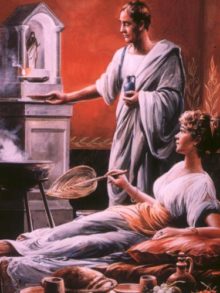 Presumed to be sons of Mercury and Lara, Lares are beneficent and friendly spirits, and deeply venerated by ancient Romans. In every house there was at least one little statue, and through these small statues, the Lare was presumed to take part in all that happened inside the house. Often a statue was put on the table during the meals, and other small statues were often placed in the higher places of the house, far from the floor, or even on the roof.
Presumed to be sons of Mercury and Lara, Lares are beneficent and friendly spirits, and deeply venerated by ancient Romans. In every house there was at least one little statue, and through these small statues, the Lare was presumed to take part in all that happened inside the house. Often a statue was put on the table during the meals, and other small statues were often placed in the higher places of the house, far from the floor, or even on the roof.
The Lares were worshiped in small sanctuaries or shrines, called Lararium, which could be found in every Roman house. They were placed in the atrium (the main room) or in the peristylium (a small open court) of the house. Here people sacrificed food to the Lares on holidays.
Care and attendance to domestic Lares could include offerings of spelt wheat and grain-garlands, honey cakes and honeycombs, grapes and first fruits, wine and incense. They could be served at any time and not always by intention: as well as the formal offerings that seem to have been their due, any food that fell to the floor during house banquets was theirs. On important occasions, wealthier households may have offered their own Lares a pig.
A household’s lararium, a shrine to the Lares Familiaris, usually stood near the hearth or in a corner of the atrium. A lararium often had the appearance of a cupboard or a niche containing a small statue, a niche painted on a wall, or a small freestanding shrine. Sometimes the Genius of the head of the household, pictured as a bearded or crested snake, or as a man with the fold of his toga covering his head, is depicted with the Lar.
Iconography: Lares are usually depicted as two young men with a watch dog; if depicted in serpentine form, then they may be crowned.
The Lares Compitales, the guardian spirits who protected local neighborhoods were housed in the crossroad shrines which served as a focus for the religious, social and political life of their local, overwhelmingly plebeian communities. Shrines were erected at crossroads. These shrines were usually open in all directions so that the Lares could travel as needed.
More about the Lares Compitales and their festival and feast days can be found here:
